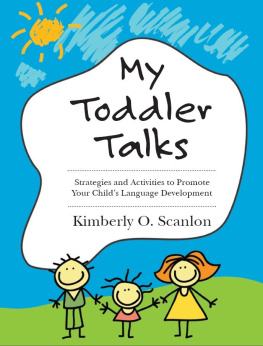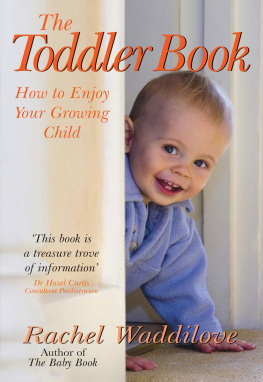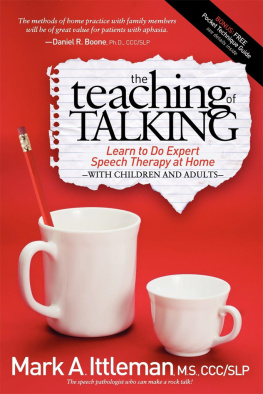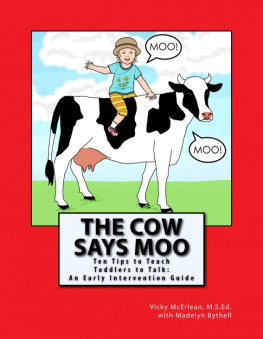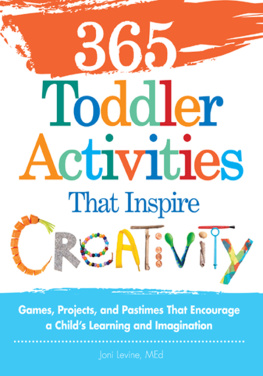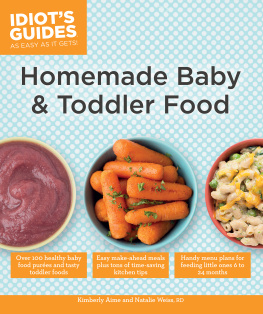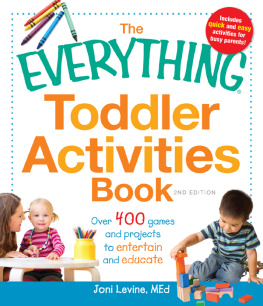.
Copyright 2012 Kimberly Scanlon, M.A., CCC-SLP
All rights reserved.
ISBN: 1477693548
ISBN-13: 9781477693544
eBook ISBN: 978-1-62112-847-2
Library of Congress Control Number: 2012911222
Createspace, North Charleston, SC
.
Table of Contents
.
I would like to thank all my clients, previous and current, for inspiring me to write this book. Watching your children blossom and grow has been so rewarding. I consider myself blessed to have the opportunity to work with such caring and dedicated parents. Thank you for making my work days so enjoyable.
Completing this book would not have been possible without the loving support of my husband Ryan and my parents, who always encouraged me to sit down and stay with it. Thank you for keeping me motivated when I needed it most.
Last but not least, thank you to my good friend and fellow speech-language pathologist Jolene Lawton, for so carefully reading and editing my book. Thanks for your attention to detail and for painstakingly correcting any punctuation or style errors. Youre the best!
.
KIMBERLY O. SCANLON, MA, CCC-SLP
Kimberly is a New Jersey licensed speech pathologist and is nationally certified by the American Speech and Hearing Association (ASHA). She is a creative thinker and a passionate therapist who believes that children should have fun in therapy. Kimberly has had the opportunity to hone her skills by working in various settings serving all ages, populations, and disorders. She is a two-time recipient of ASHAs award for continuing education (ACE), which formally recognizes professionals who have demonstrated their commitment to lifelong learning by earning seven CEUs (seventy hours) within a thirty-six-month period. She graduated from Rutgers University with a bachelor of science and earned her master of arts in Communication Disorders from Montclair State University. In addition to writing, Kimberly is busy running her private practice, Scanlon Speech Therapy, LLC, in New Jersey. If you are interested in learning more speech and language tips, techniques, and activities, please visit her website, www.scanlonspeech.com. Kimberly lives with her wonderful husband, Ryan, their delightful daughter, Kerrigan, and their very cute but mischievous chocolate Labrador retriever, Barney.
.
If you have genuine concerns regarding a childs speech, language, and play skills, please consult a licensed and certified speech-language pathologist for guidance. This book is not meant to replace speech therapy. For those children in speech therapy, it can be used in conjunction with the recommendations of the treating speech-language pathologist. Please be advised that Kimberly Scanlon, MA, CCC-SLP, is a licensed speech-language pathologist. Kimberly may recommend products, toys, and activities, which, if properly used, may be educational in nature to help adults work with children to improve their language skills. Kimberly hereby disclaims any and all liability occurring as a result of any alleged or actual claims against her as a result of the usage of these products. Please be aware and be guided accordingly that the products recommended by Kimberly may contain small parts which may cause a choking hazard, and they should never be used by children unless under the strict supervision of an adult. Kimberly does not guarantee speech/language progress or that children will want to engage in play with their parents and/or do the recommended activities. This book is not intended to, nor could it take the place of the advice and/or intervention from, a physician, speech-language pathologist, or early-childhood provider who has evaluated your child in person. It is not speech-language therapy, nor is it a professional assessment of any childs speech and language skills.
.
Stop right there. Before you even think about skipping the introduction and going straight to the play routines, let me strongly suggest that you read the introduction first. Since there is so much valuable information in the introduction, I even recommend reading it more than once. Enjoy and happy reading. I wish you much success!
.

A re you interested in jumpstarting your toddlers speech? Would you like to learn some strategies to help your child talk? If so, then you are reading the right book! This book has been written to help parents and caregivers facilitate the communication and play skills of their toddlers. My play activities and techniques are straightforward and easy for nonprofessionals to implement. It is my goal that readers will become so comfortable using the learned strategies that they will apply them throughout the day with their children. Educators, speech-language pathologists, and others working with or interacting with toddlers will also find this book helpful. The activities were written primarily for children aged eighteen to thirty-six months old, but younger or older children can also benefit, depending on their skills, personality, and maturity. For simplicity, the term parent will be used to include any adult who wishes to participate in fun play routines and to learn language-enhancing strategies. The terms toddler and toddlers will also be used to represent the targeted age group. The male gender pronouns (he, him, and his) will be used to keep things succinct.
Toddlers are a very curious bunch. Most are hands-on and enjoy exploring their environment and discovering new toys and objects. All this curiosity helps to drive their learning. Play is an essential learning tool for toddlers and is very important to their overall development and cognition. In addition to helping them communicate and socialize, play further develops problem solving, attention, hand-eye coordination, visual perceptual, and fine motor skills. Research shows that certain play skills, language structures, and specific cognitive concepts occur simultaneously during the same stage of development. For instance, for a child to engage in pretend play, he has to have the ability to understand that objects can be used symbolically to represent other objects. At the same time, he has to have enough language to engage in social dialogue and negotiation to make the pretend play meaningful. For more information on how play relates to language, please see .
A childs language and cognitive development is additionally boosted when an adult appropriately plays and engages with him. Furthermore, play helps to strengthen the bonds between parent and child. This is because play allows a parent to enter a childs world. Play provides a relaxed, secure context to offer parental assistance and guidance.
Over the years, I have educated many parents and adults on how to effectively engage and play with toddlers. I have discovered that some adults are not comfortable playing with toddlers, or they are not confident in their own play skills. Either the play is too simple or, more often, too advanced. The latter may happen because some adults have very high expectations of toddlers abilities. Parents also have to be careful not to be overly controlling during play. When this occurs, the benefits of play are greatly diminished because the adult takes away the childs ability to be creative and solve problems. For these reasons, I have provided directions on how to facilitate the toddlers independence, creativity, and problem-solving skills. Although my play routines are structured by the adult, the toddler ultimately makes the decisions and leads the way. The adult merely serves as a facilitator.

